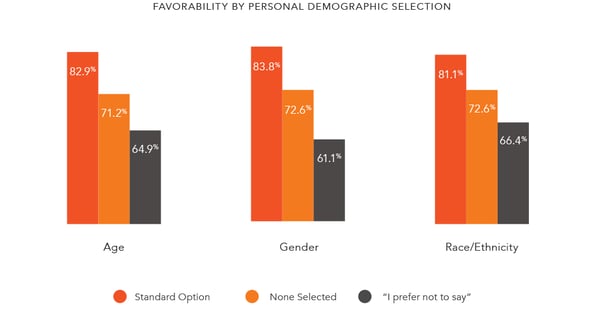
 If you’ve read Quantum Workplace’s annual Employee Engagement Trends Report, you know that we collect perceptions of organizational culture from hundreds of thousands of employees across the United States annually.
If you’ve read Quantum Workplace’s annual Employee Engagement Trends Report, you know that we collect perceptions of organizational culture from hundreds of thousands of employees across the United States annually.
While nationwide year-over-year engagement is an interesting metric, the really fascinating results appear when we slice the data by demographics, including organizational (e.g., industry, size), professional (e.g., tenure, department), and personal (e.g., age, gender).
Because personal demographics – age, gender, and race/ethnicity – can be sensitive topics for some individuals, we give all respondents the option to select “I prefer not to say.” Selecting “I prefer not to say” allows employees to express the sensitivity they have around disclosing their personal demographic as opposed to leaving the item blank (which registers as a missing data field and is filed under “None selected”).
But after analyzing the perceptions of employees who selected “I prefer not to say,” I found some interesting results.
Rather than showing a complete breakout of results for every demographic, the graph below summarizes the average favorability for respondents who selected 1) the “standard” demographic option with lowest favorability, 2) nothing (i.e., missing data), and (3) “I prefer not to say.”

Across the demographics of age, gender, and race/ethnicity, respondents who selected “I prefer not to say” consistently had much lower favorability than those who selected a standard option or left the item blank.
What’s most fascinating is that those respondents didn’t simply skip the item; they wanted to show leaders that they preferred to not disclose personal information about themselves.
To me, this suggests the following:
Employees who prefer not to share their personal demographics do not want to divulge information that may make their responses attributable, but they want you to know they have concerns about being transparent. In other words: employees don’t trust in leadership, and they want leaders to know it.
This is a heavy claim, but it’s the only conclusion that makes sense to me after thinking it through. If I have highly uncertain or unfavorable opinions about my organization, I might also believe that my organization isn’t trustworthy.
My employer might even have malicious intent for the survey data, such as blocking employee promotions/raises, firing employees who gave especially low ratings, or public shaming. If I think all of that — about being suspicious of my employer — then I’m less likely to be forthcoming about who I am.
But my opinion of the organization is so low that I will want to remain “pseudo-anonymous”: you won’t know my gender, age, or race/ethnicity (so you can’t track me down), but I also need you to know that I don’t want you to have that information.
We typically think of trust as an upward phenomenon, that it’s important to focus on the trust that individual contributors have in leadership. We typically think of transparency as a downward phenomenon, that it’s important for senior leadership and management to be transparent to individual contributors.
Yet the results presented above suggest that it’s also important to think about and appreciate upward transparency, or the information that lower-level employees are willing to divulge to management and senior leadership.
There is a feedback loop of trust and transparency in the workplace. If I as an individual contributor perceive leadership to be untrustworthy and not transparent, I’m less likely to be transparent and trust the organization with my feedback, which reduces the specificity of my feedback, which reduces the ability of leadership to focus their efforts around demographic-based initiatives (e.g., diversity and inclusion).
But if I as an individual contributor trust in leadership and believe leaders are transparent with me, I’m more likely to give them my trust and be transparent when giving feedback (such as with surveys). This transparency can arm leadership with more detailed information to pinpoint specific and focused action planning toward the betterment of the organization.
Do your employees trust in leadership? Download our ebook below to uncover 35 strategic choices that foster employee trust in leadership.
Published July 25, 2017 | Written By Dan Harris, Ph.D.